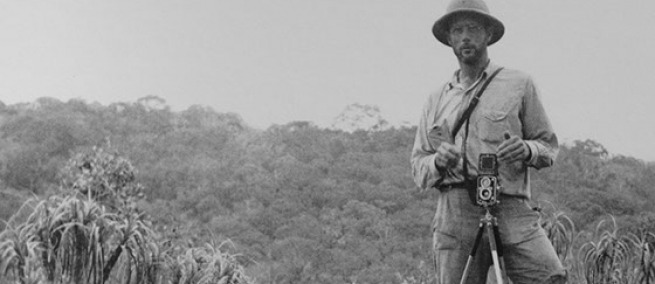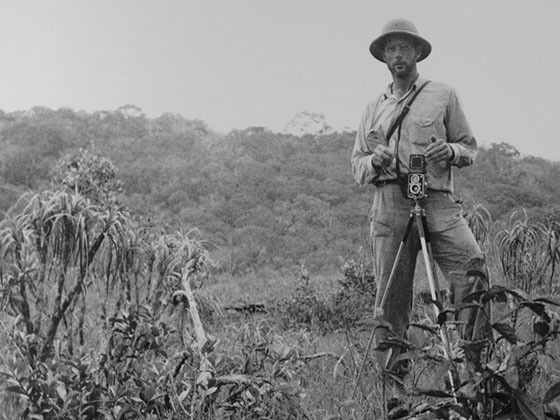
Wade Davis has been travelling to South America since he was 14 years old. Between 1999 and 2013 he served as Explorer-in-Residence at the National Geographic Society. He is currently Professor of Anthropology at the University of British Colombia. A photographer and filmmaker, he is the author of 20 books, which have appeared in 19 languages. One River (1996), tells the story of his mentor the botanical explorer Richard Evans Schultes. Schultes is one of the inspirations for Ciro Guerra’s Oscar-nominated and Sloan-Sundance winning film EMBRACE OF THE SERPENT, which takes place in the Colombian Amazon. It tells the story of two white explorers—an ethnologist and a botanist—who explore the Amazon in search of a sacred plant. Science & Film spoke with Professor Davis on the phone about his experience in Colombia and the impact of the film:

Science & Film: I spoke with Ciro Guerra, director of EMBRACE OF THE SERPENT, and he said there has been a resurgence of interest in the lives of the scientists on which the film is loosely based: Richard Evans Schultes and Theodor Koch-Grunberg. Have you seen that?
Wade Davis: Richard Evans Schultes never kept a journal in the Amazon. He was so busy collecting plants. People forget that anthropologists are studying the cultures, taking copious notes; a botanist is working all day in the forest collecting plants and then spending all night processing the plants and it’s very laborious and exhausting. So Schultes never kept a journal except for seven months on the Rio Negro in 1947 but what he did do, like all botanists, is keep impeccable notes on his collections. For example, when I wrote the book One River, which is in part his biography, what allowed me to do it–given that he was a terrible witness to his own life, he had no sense of narrative, no sense of mythology, no sense of his place in history, and he was not a really good storyteller in the sense that most of what he remembered from the Amazon he had distilled into a series of stories, old chestnuts really that were at best only partially true.
I did about 30 hours of interviews with him originally and that set me back six months. So what allowed me to actually to write the book were three things: one, is that he had worked for the US Government all those years so I knew somewhere in the archive were real-time reports that he would have sent back; secondly, he took thousands of photographs and he catalogued them as to place, subject, date, and so on; the third element was that he was collecting all the time and a botanist always records the location, the date, the elevation, the habitat, and so on of the collection. Those three things allowed me to reconstruct his life as I did.
Schultes had any number of misadventures. He was nearly killed in an airplane, from disease (he had malaria 27 times), he had seen men drown in rapids–it was not like he did not see certain perils, but he considered the Amazon a garden. Every moment he was there he was in paradise, and he had nothing but wonderful relations with the native people who absolutely revered him. What made Schultes so special was that he was the only outsider the native people had ever encountered who didn’t want to rape their daughters, didn’t want to steal their labor, didn’t want to subvert their religious beliefs. He was just a solitary student of plants who went to the people as a student of botany not as a master of it.
S&F: How did Colombians respond to the film?
WD: What Colombians say and feel about the film is that it is very different than Werner Herzog’s FITZCARALDO which everyone felt was almost exploitative. What they say about Ciro’s film was it is the first attempt to show that era through the eyes of the native people. My reaction to the film, which I saw in a private screening with a good friend of mine Héctor Abad Faciolince who is Colombia’s most highly regarded novelist of our generation, and Hector who like most urbane Colombians has rarely been to the Amazon if at all. I think it was good Ciro tried to capture something of the viewpoints of the native people.
There was another element of the film which I think is very wonderfully Colombian. Everything was sort of pushed over the top in the phantasmagoric scenes of the dreadful Capuchin priests. First of all, the priests were truly dreadful. Schultes went down the Rio Putumayo where the worst of the atrocities occurred during the time of César Arana and he met a priest who had lived through that period of time and the priest said that the best thing that could be said about a white man in that era of the rubber boom was that he didn’t kill his workers for sport. There was a rationale for the atrocities. The key thing about rubber is because of the South American leaf blight the rubber trees grow widely dispersed in the forest and whenever concentrated in plantations the blight becomes virulent and kills all the trees. In order to tap the millions of trees scattered across the forest the size of the continental United States you had to mobilize huge armies of labor. When the people pouring into the Amazon from the northeast of Brazil proved insufficient to the need they had to turn to the Indians, and then they had a problem: how do you secure the trade with the native people who in the face of adversity could just flee into the forest they knew so well? The answer was terror. And so, the terror was deliberately utilized as a way of traumatizing the Indians and keeping them working. So some of those scenes in the film are not off the mark.
S&F: How did you feel about the fantastical elements of the film?
WD: There is also a wonderful element of magical realism in EMBRACE OF THE SERPENT. People talk about magical realism when it comes to Colombia but if you know Colombia well, and I know it extremely well, the really wonderful thing about it is that magical realism in Colombia is actually journalism. In other words, the kind of magical realism you find in literature, you think this is only the product of the imagination of the author but no it is not. Things like that happen in Colombia. You meet characters in Colombia all the time that make the writing of a guy like Gabriel Garcia Marquez seem completely tame and boring and tediously grounded in reality. There is always a surrealistic thing happening in Colombia. A conversation I had last time in Colombia was someone told me their father used to take them down the Rio Magdalena on one of the river boats and he remembered being five years old and running aground and spending the entire afternoon on the bough watching the corpses of the dead float by, and perched on them were vultures picking at the flesh.
When I first went to Colombia when I was 20 parents of friends I met would say, why do you possibly want to live with the dirty people, the Indians, and that’s where Colombia was then. It’s not there now at all. Native people have become in many ways symbols of pride. Certainly Schultes didn’t ever feel the forest was anything but benign.
S&F: I read that the one of the actors read your book before beginning work on the film.
WD: Ciro contacted me when he was making the film and he wanted to get some of the archival images of Schultes which I was happy to facilitate, but it was just one of a thousand requests I get every month so I didn’t realize what it would become. My book One River, it was translated by a Colombian poet, and it’s a total cult book in Colombia. Everybody’s read it. The key thing is that it came at a time when nothing good was being written about Colombia because of the violence. Suddenly, this big fat book about botany comes out of a travel adventure by a young person who was free to travel with impunity and joy wherever I wanted to go. And similarly Schultes never said a bad word about Colombia. The whole thing became this love letter to the country and was embraced as such. To give you an example: the head of one of the largest corporations in Colombia read the book and decided for their 100th anniversary not to celebrate the company but to pay for teams of journalists and naturalists to go to all of the five major regions of Colombia and put together books of natural history and beauty. Books that would not be sold but each set of five books would be given to every single school and every library in the country of Colombia as a message to a new generation of Colombians saying: we’re not the country of drugs we’re the country of beauty. Then, when he finished that project, I said well why don’t we do the rivers, and he said that’s a great idea. So we are doing the Rio Magdalena right now—I mean I’m leaving to Colombia tomorrow to finish the research for that book.

That gets back to an important point about Ciro’s film, which is that Colombia is exploding intellectually right now. Two generations of young people who had to flee the country because of the violence and the kidnapping are now all going home and they’re going home with huge amounts of intellectual capital in the arts, sciences, and technology, and so Colombia’s future is really bright. There is a kind of a national spontaneous burst of resurgence. Part of which is a peace process but part of which is the fact that the country has come out the other end of a terrible period of violence that it was actually not responsible for.
I think the film and the fact that it was nominated for an Oscar will be great not only for Colombia’s film industry in general but also for Colombia in general. My reputation in Colombia is always surprising to me because it is not really deserved in a certain sense. But in a way it is a reflection of how thirsty and starving the Colombian people have been for validation in a sincere way. I think that the respect that I get down there is both wonderful but it is kind of sad to me, I don’t mean that in the patronizing way, but I think it is a reflection of how the place has been unjustly treated and viewed because even during all the years of violence it maintained civil society, it maintained democracy, it maintained economic growth, it created a network of national parks, it has done more to help the native people of the northwest Amazon than any other country in South America, and the cities have become green cities compared to what they once were. There is a lot of good news in Colombia that never gets out. I think this film is all part of a reversal of all that. I am not the only person who knows and loves Colombia who is doing whatever they can in a very sincere way to help rebrand the country. And so I think the film will play a major important role in all that.
EMBRACE OF THE SERPENT is now in theatres. On Science & Film is a published interview with the director Ciro Guerra.
FILMMAKERS
PARTNERS
TOPICS